The 1859 cable.
- Home, index, site details
- Australia 1901-1988
- New South Wales
- Overview of NSW
- Telegraph lines
- Telegraph Offices
- Date stamps
- Forms
- Envelopes
- Rates
- Stamps
- Queensland
- Overview of Qld
- Telegraph lines
- Telegraph offices
- Date stamps
- Forms
- Envelopes
- Rates
- Stamps
- South Australia
- Overview of SA
- Telegraph lines
- Telegraph Offices
- Date stamps
- Forms
- Envelopes
- Rates
- Stamps
- Tasmania
- Overview of Tasmania
- General developments
- Reports
- Organisation
- Telegraph lines
- Telegraph Offices
- Date stamps
- Railway lines
- Forms
- Envelopes
- Rates
- Stamps
- Overview of Tasmania
- Victoria
- Overview of Vic.
- Telegraph lines
- Telegraph offices
- Date stamps
- Forms
- Envelopes
- Rates
- Stamps
- Ephemera
- Western Australia
- Overview of WA
- Telegraph lines
- Telegraph Offices
- Date stamps
- Forms
- Envelopes
- Rates
- Stamps
Details are summarised here of:
- breakages in the 1859 cable;
- the final breakdown and after.
The misgivings felt by McGowan during the laying of the cable (and reported elsewhere) soon came to fruition. Interruptions in transmission occurred from nearly the start of the operation. Within a few weeks, problems included:
- a break at Victoria Cove, King Island because the bottom was more rocky than had been expected(see below);
- the realisation that the outer covering was defective;
- numerous breaks between Three Hummock Island and King Island;
- the strength of the currents around Stanley which quickly cut the cable (Crawford, p. 402).
On 17th October, McGowan issued the following notice:
"It is hereby notified that, in consequence of an interruption having occurred in the submarine section of the line between King Island and Cape Otway, the communication will not be available to the public until the necessary repairs may have been completed".
The Hobart Mercury of 11 November 1859 commented as follows:
"Our beautiful cable is in sad tribulation. Tenderly nurtured as it was, it has proved too weak for the rough treatment it has experienced. It bore up manfully against its ill usage until it had delivered the congratulatory addresses of their Excellencies and then fell a victim to the rocks amongst which it had unfortunately been laid at Victoria Cove.
Of course, the great question now is - on whom ought the blame to rest? That the character of the coast at the point where the cable was landed was most incorrectly described in the survey which was made for the purpose of determining the best and safest landing places is now too apparent. The landing place at Victoria Cove was described by the Marine Surveyor as " being most " favourable, as the depth shallows very regularly from ten fathoms upwards upon a good sandy bottom free from rocks all the way.
Instead of this being an accurate description, we are told that at the place where the cable has been landed in obedience to this survey, rocks exist which would, so nautical men say, sever a ship's chain cable by the friction in a dozen pieces before it had been in contact with them many days.
Capt. Tribe has written to the Melbourne Herald upon this subject, and states that, knowing Messrs. Henley & Co., as I do, I have no hesitation in stating that they never could have been made acquainted with the nature of the localities in which the cable was to be laid, or I am convinced they never would have allowed their cable to leave England without long heavy shore ends or without condemning the route over rocks and kelp ...
Captain Tribe further states The moment I saw Victoria Cove, I told the contractor, in the presence of many witnesses, that the Cable would last no time there. And he adds the only safe and wise course now to be pursued is to pick up the Cable from the landing place, Victoria Cove, to some ten or twelve miles out to sea where a fair sandy bottom exists, there cut it, splice on the spare new piece and carry it round to the sandy patch on the N. E. corner of King's Island. It is a thousand pities to see the Cable lying useless as it is with each of its shore ends wearing hourly away".
On 28 December, 1859 the Argus reported that "the Tasmanian cable has, after a long interval of silence, spoken again and messages from Hobart Town were yesterday received in this city (Melbourne). The first telegram was a message of congratulations addressed by the Chief Secretary of Tasmania to the Treasurer of Victoria".
Various newspapers in February 1860 carried the story that "telegraphic communication with Tasmania has again been interrupted since 8 30 a.m. Thursday (16 February). The break occurred in the submarine cable between King's Island and Circular Head". Finally, on 21 April 1860, a section parted between King's Island and Hunter's Island. McGowan noted the problem in his 1860 Report. The annexed documents (letters) are also provided below:
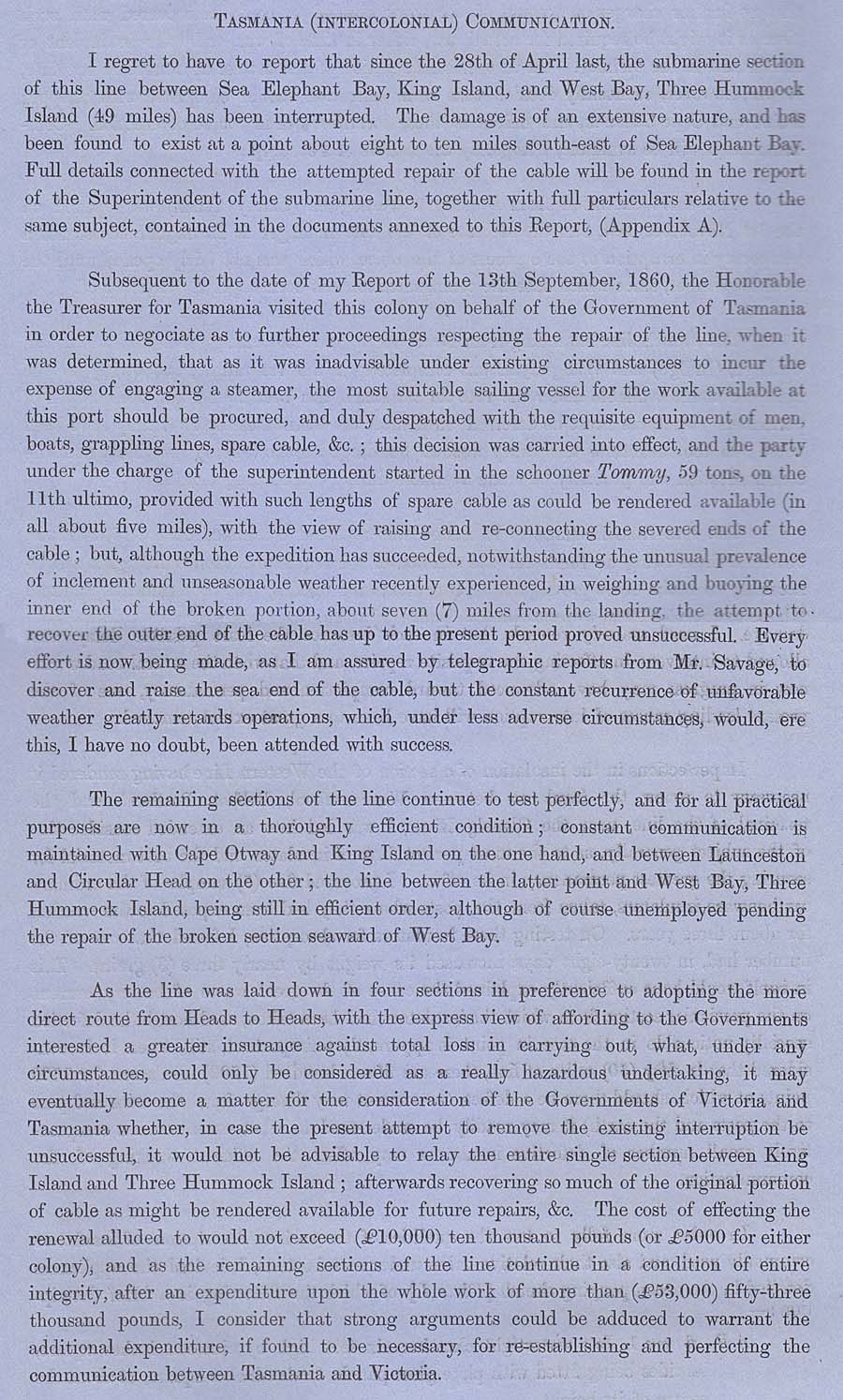 |
On 9 July 1860, McGowan summarised the position of the cable to his Postmaster0General as follows:
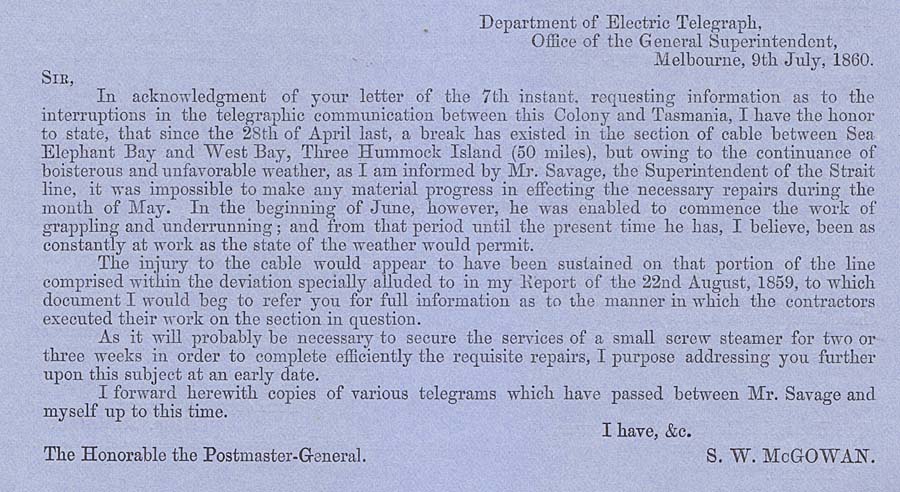 |
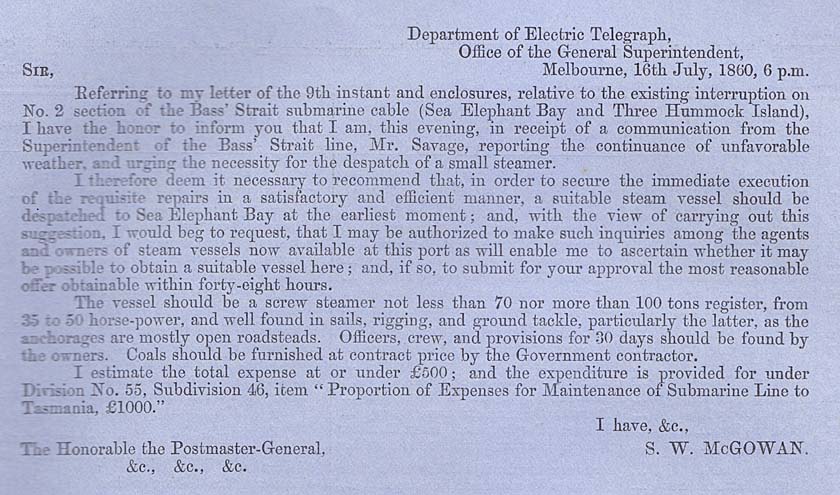 |
 |
 |
Mr. Savage had given his best endeavours despite the odds against him to repair the cable. Some his tribulations are summarised in the following communication:
 |
McNaughton continued to place the blame for errors on the lack of a proper survey:
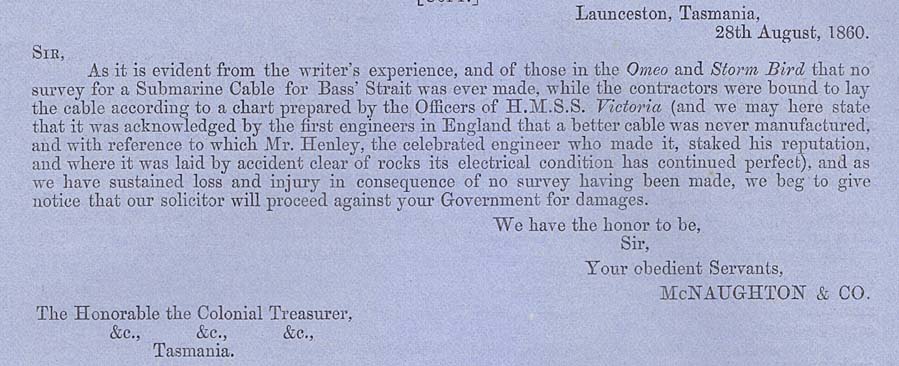 |
In September 1860, McGowan summarised some of the main considerations and tried to look forward to a possible resolution.
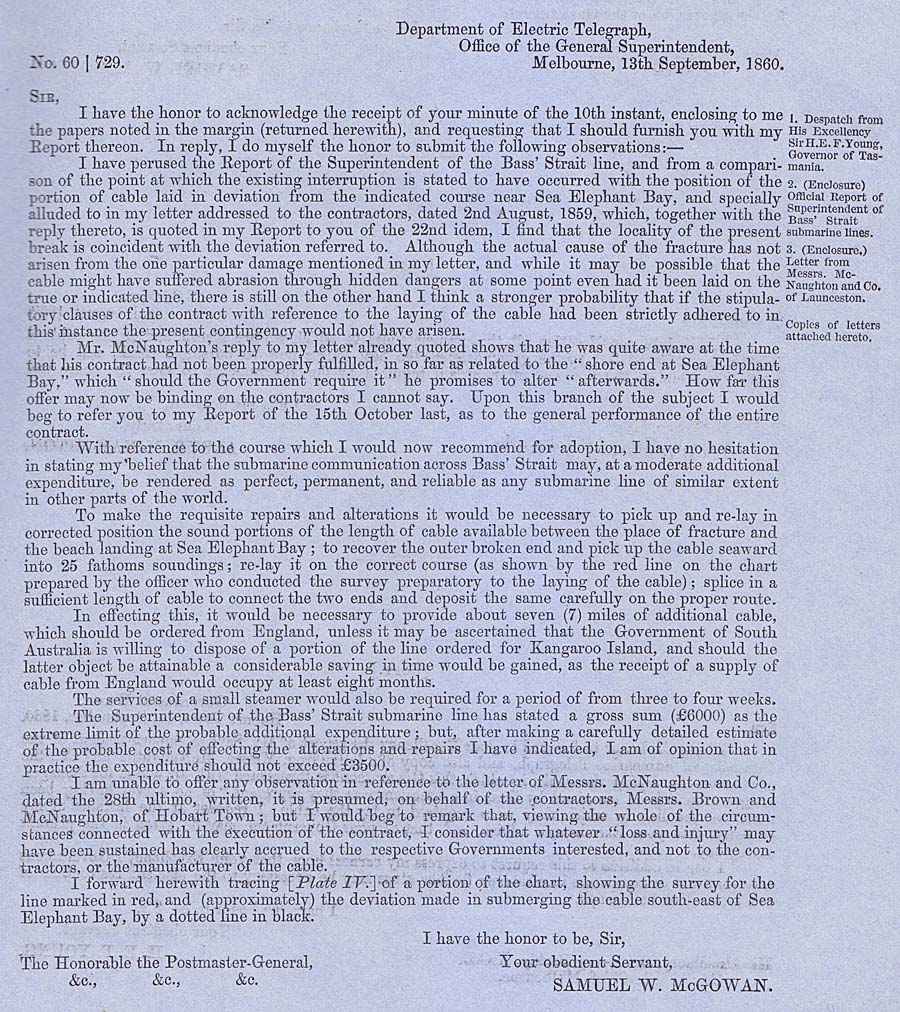 |
By the end of 1860, the Cape Otway to King's Island portion was separated and others were destroyed soon afterwards. As noted - especially in Savage's Report of 21 August above - the main cause of the problems was the abrasion of the cable on the rocks on the uneven bottom of the sea and the heavy current in the channel. The cable had by then fallen silent and never again transmitted a message.
Accidents did happen however to add to the poor quality of the cable and the problems with laying. One of the final accidents and perhaps the most important was when a break between Low Head and Stanley was caused by the anchor of the Princess Louise - caused by the waters in that area being too shallow. The South Australian Register of 8 February 1861 ran the following story first published in the Examiner:
The Tasmanian Submarine Cable.
"The brig Princessan Luise from the Mauritius, whilst weighing her anchor in Lagoon Bay, near Tamar Heads, drew up about 40 fathoms of the Submarine cable, which was brought to town late on Friday night by the steam tug Tamar. Communication with Circular Head is thus cut off.
But whilst it is to be regretted that such an accident has, for the time, interrupted communication with Circular Head, still the lesson which may be learned from the 40 fathoms of cable which have been brought to town, and which were laid on a sandy bottom, is such as may yet prove of service to the colony. Experientia docet ("experiences teaches") is a truism which may now be studied with great advantage with respect to the submarine cable which some time since connected Tasmania with the Great Australian Continent.
What the state of that cable is from King's Island to Cape Otway it is, of course, impossible to say; what it is from the Hummocks, the prolonged absence of Mr. Savage in repairing it and the absence of any report from him on the subject, leaves us only to conjecture — and the conjectures cannot be other than of a gloomy character; what it is in Lagoon Bay — a spot with a sandy, shelly bottom— the 40 fathoms dragged up by the chain cable of the Princessan Luise have offered ample evidence. The portion of the cable which has been brought to town, and which was upheaved from its subaqueous bed on account of the wires which protected the wire conveying the electric current becoming entangled in the cable of the brig, is in itself an evidence that cables constructed like the Tasmanian cable are not capable, even when laid upon a sandy bed, of withstanding the chemical action of the water and the mechanical force of the powerful currents which prevail in the Straits.
The cable, which has been brought to Launceston by the Tamar, exhibits this in a remarkable degree. In several places, the outside coating of iron wires is wholly worn away, leaving the insulating of gutta percha which surrounds the conducting copper wire protected only by a covering of ropeyarn saturated with tar. If iron wire could not resist the action of the tidal currents, it must be evident that such fragile materials as tarred ropeyarn and gutta-percha would offer but a feeble resistance; and this being the case, it becomes a matter of serious consideration for the two Governments of Victoria and Tasmania, whether it is worth while to expend any more money in repairing a cable which at best will only prove a source of annoyance and in a short time may become altogether useless. The protecting wires are evidently of too slight a texture to withstand the tidal currents and the chemical action of the waters of Bass's Straits; and under these circumstances any more money spent in attempts to repair the cable would be absolutely a useless expenditure.
We hear that these facts have been communicated to the Victorian Government, and with them in a great measure will rest the responsibility of any future expenditure for repairs. Whether they choose to continue these in the present detective state of the cable we know not; but this we do know — that the iron wires forming the outside covering of the cable between England and France are at least three times greater in diameter than those which protect the Tasmanian cable".
Attempts were made in a number of ways to make the cable work. The November 1859 Hobart Mercury article above went on to add:
"The advice (to move the cable away) has been acted upon, and is now, we believe, being carried out. A new contract has been entered into with the contractors for the removal of the cable to the place indicated and for the additional cable necessary to do this. Fortunate indeed was it that McNaughton & Co. took the precaution to order more cable than was absolutely required for the fulfilment of their contract. The alteration in the route of the cable will also necessitate a corresponding alteration in the land line across King's Island which will now have to be extended to the new landing on the N.E. corner of the Island. It is, therefore probable that three weeks or a month will elapse before communication with the other colonies will be restored".
If ONLY!!!!
In a creative yet desperate move to retrieve the investment by both Governments, the possibility of leasing the cable to the private sector was entertained briefly.
On 5 April 1865, in reply to a question in the Legislative Council, Mr. Verdon replied that the Tasmanian Government had no plans to repair the telegraphic cable between Tasmania and Victoria.